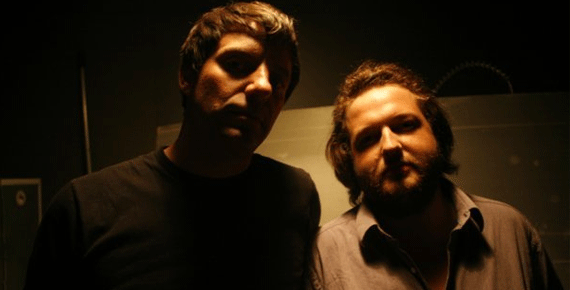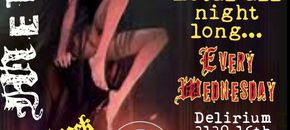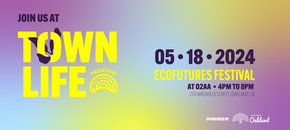Q&A: EO of Moniker and Polk & Hyde
This Friday, October 19, Realtime returns to 222 Hyde with a stacked line up headlined by Reagenz, a collaborative project between German-based producer Move D and Jonah Sharp. For those unfamiliar, Realtime is 222’s all live monthly, featuring an improv set from residents Jonah Sharp and Emilio Orlandi, aka EO, as Polk & Hyde. Additionally, EO will be performing a special set with Kenneth Scott as Moniker since they reunited in the last few months.
EO came into contact with the SF rave scene back in the late 90s and his involvement extends to his current position as 222’s head honcho. I got a word in with him to learn more about his history and what he loves about playing dance music live and improvised.
What drew you to dance music?
I was drawn to dance music from listening to heavy dub reggae and the production techniques used by Lee Perry, King Tubby etc. The use of the mixing board as an instrument, and the use of delay, reverb etc got me interested in more electronic sounds found in house music, techno etc.
When did you first approach the SF rave scene? How has it changed since you got involved?
I got involved in 1999 when I started going out to events like Wicked at 177 Townsend Street. I started buying records and teaching myself to mix in my bedroom, and I quickly picked up gigs around town after a few months of practice. I also helped run an underground space in downtown Oakland from 2001 till its close in 2004. It was a basement on 15th street between Harrison and Webster, and that’s what it was: a dirty, little sweaty basement. Sound familiar? Then there was a studio space I had on Howard Street where many an afterparty was born. When I got involved in 222 Hyde in 2009, all my energy went into making a go of a legit space to hear the music we all love.
How did you meet Kenneth and when did you partner up as Moniker?
We met at the Compound, or Kontrol. I had a studio full of old analog gear and Kenneth and I discussed getting together and seeing what happened in the studio. I had been teaching myself the ropes of hardware and producing a bit (and jamming out even more), and Kenneth was coming from a software based background in production. We had chemistry in the studio right off the bat and we’ve been working together ever since.
Kenneth moved to Berlin for a moment. Now that he’s back, do you intend on picking up the pace with Moniker again?
Yes! We have some upcoming releases coming up and we’re being asked for more original material. Since Kenneth moved, he has progressed as an artist, as have I. [Polk & Hyde] has been really fun and fulfilling, and it has kept me busy in the studio as well as performing live. Coming back together with Kenneth was completely natural, and we picked up right where we left off.
Tell me a bit about the history of 222 Hyde. What motivated you to open the club?
222 has been around since the 1940s in one form or another. I’m sure a book could be written about the corner of Turk & Hyde where the world famous Black Hawk jazz club was located, and 222 was a sort of “green room” for visiting artists such as Miles Davis, John Coltrane, etc. I’ve even heard that back in the day, the jazz club was segregated, and the visiting artists had to come next door to 222 to have drinks!
222 has been a dive bar, tranny bar, gay club, the whole gamut. I feel like I’m just the current caretaker of a place that has such a rich history.
When I reopened 222, there was sort of a shortage of venues in SF. There were a few bars that played house/techno, but none taking it very seriously. I love the space that 222 creates, and I saw it as a potentially great place to hear DJ/electronic music if done right.
How does it feel to do improv as Polk & Hyde? How does it compare with writing a live set?
We both feel free in the creation of music on the spot, in front of people, with no rehearsal. Its scary, yet really stimulating at the same time. I love listening back to a recording of Realtime and hearing music that neither one of us knew existed until it was played. Surprising myself with what we come up with is some of the most fun I have in the studio or live setting.
Writing a live set and playing it is just as fulfilling, but in a different way. Kenneth and I can really get each track dialed in, musically, tonally, arrangement wise. We can run through the live set and practice our transitions, get to know when things will happen and how we want them to sound. Listening back to a Moniker set that we practiced a few times and sounds really polished is a great feeling, and I wouldn’t give the edge to one style or another.
What do you feel is special about live music as compared with DJing?
The beauty of DJng is that the selector can change the mood with one record. A live performance is more of a chunk of sound that lasts for the hour or more of the performance. Some folks want to go out and hear a range of styles and tonal makeups of records and different producers. It takes a bit more commitment as a listener to go to a live event and see what the performers come up with. At a DJ event you could hear a track that drives you to the bar or to the bathroom, only to come back a few minutes later with a barn burner that brings the house down.
But what a live performance can give the crowd an experience that is truly unique. If the performance is on point, and everything is clicking, the crowd feels the music being made right in front of them.
In the case of Moniker and Polk & Hyde, they see the instruments that we lugged to the gig, connected countless cables and wires, really rebuilding our studio in the club to play for them live. That gives a different impression than a dj set to the viewer, and if that’s what you’re into, nothing else can take its place. There is room for both types of events in this environment, and we’re lucky to be able to take part in all aspects of this music in a city like SF.
Catch Realtime at 222 Hyde with Reagenz, Moniker, Its Own Infinite Flower, and residents Polk & Hyde, Friday, October 19. Tickets are $12- $15 and can be purchased here.
Photo credit: Micah Weiss







